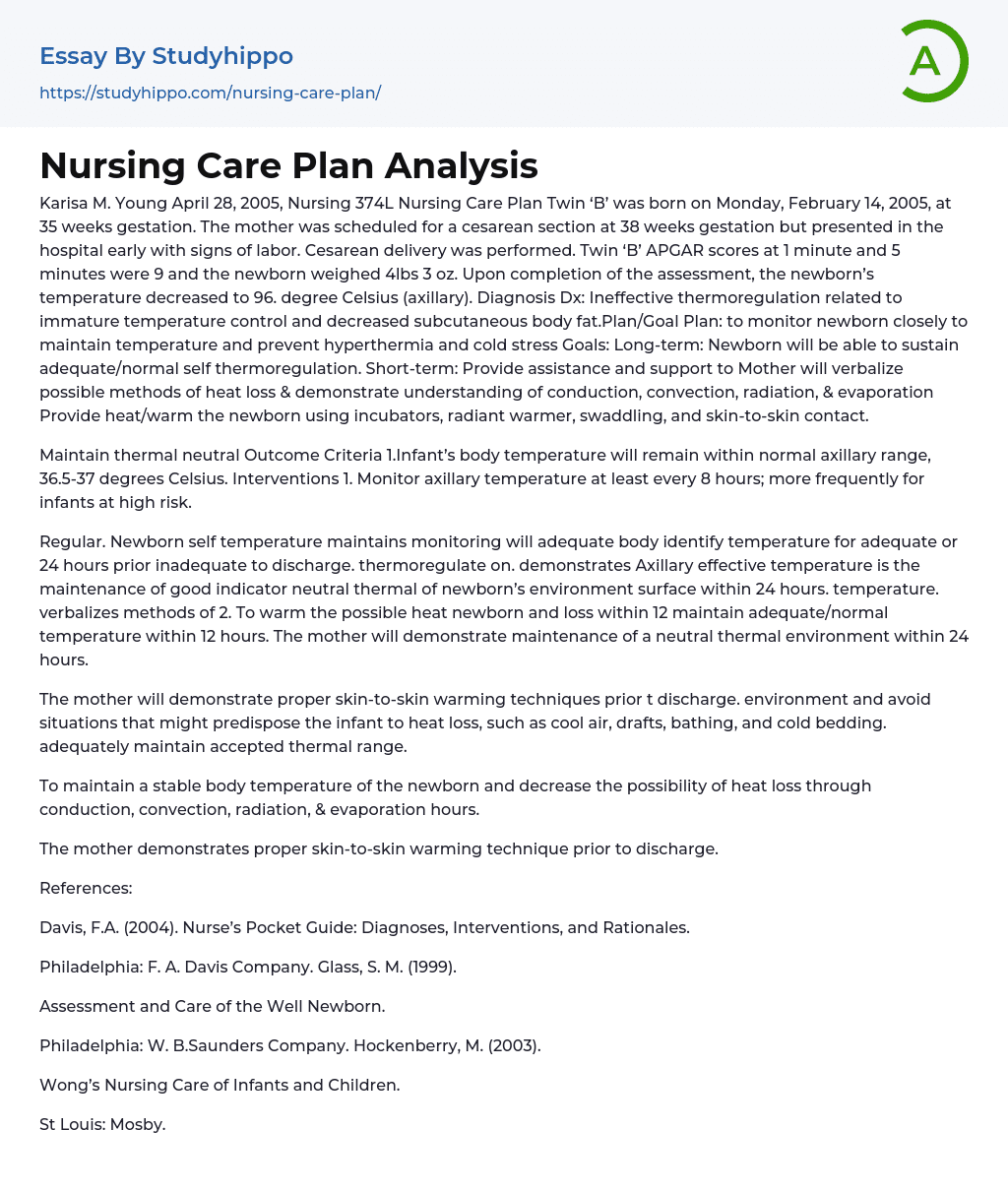Nursing Care Plan Twin ‘B’ was born on Monday, February 14, 2005, at 35 weeks gestation. The mother was scheduled for a cesarean section at 38 weeks gestation but presented in the hospital early with signs of labor. Cesarean delivery was performed. Twin ‘B’ APGAR scores at 1 minute and 5 minutes were 9 and the newborn weighed 4lbs 3 oz. Upon completion of the assessment, the newborn’s temperature decreased to 96. degree Celsius (axillary).
Diagnosis Dx: Ineffective thermoregulation related to immature temperature control and decreased subcutaneous body fat.Plan/Goal Plan: to monitor newborn closely to maintain temperature and prevent hyperthermia and cold stress Goals: Long-term: Newborn will be able to sustain adequate/normal self thermoregulation. Short-term: Provide assistance and support to Mother will verbalize possible methods of heat loss & demonstrate understanding of conduction, convection, radiation, & evaporation Provide heat/warm the newborn using incubators, radiant
...warmer, swaddling, and skin-to-skin contact.
Maintain thermal neutral Outcome Criteria 1.Infant’s body temperature will remain within normal axillary range, 36.5-37 degrees Celsius. Interventions 1. Monitor axillary temperature at least every 8 hours; more frequently for infants at high risk.
Regular. Newborn self temperature maintains monitoring will adequate body identify temperature for adequate or 24 hours prior inadequate to discharge. thermoregulate on. demonstrates Axillary effective temperature is the maintenance of good indicator neutral thermal of newborn’s environment surface within 24 hours. temperature. verbalizes methods of 2. To warm the possible heat newborn and loss within 12 maintain adequate/normal temperature within 12 hours. The mother will demonstrate maintenance of a neutral thermal environment within 24 hours.
The mother will demonstrate proper skin-to-skin warming techniques prior t discharge. environment and avoid situations that might predispose the infant to
heat loss, such as cool air, drafts, bathing, and cold bedding. adequately maintain accepted thermal range.
To maintain a stable body temperature of the newborn and decrease the possibility of heat loss through conduction, convection, radiation, & evaporation hours.
The mother demonstrates proper skin-to-skin warming technique prior to discharge.
References:
- Davis, F.A. (2004). Nurse’s Pocket Guide: Diagnoses, Interventions, and Rationales.
- Philadelphia: F. A. Davis Company. Glass, S. M. (1999).
- Assessment and Care of the Well Newborn.
- Philadelphia: W. B.Saunders Company. Hockenberry, M. (2003).
- Wong’s Nursing Care of Infants and Children.
- St Louis: Mosby.
- Hospital essays
- Physician essays
- Health Care Provider essays
- Universal Health Care essays
- Readmission essays
- Psychometrics essays
- Measure essays
- Why I Want to Be a Nurse essays
- Nursing Profession essays
- Why Did You Choose Nursing essays
- Action Potential essays
- Blood essays
- Body essays
- Brain essays
- Childbirth essays
- Eye essays
- Glucose essays
- Heart essays
- Human Physiology essays
- Immune System essays
- Kidney essays
- Muscle essays
- Nervous System essays
- Neuron essays
- Poison essays
- Puberty essays
- Sense essays
- Skeleton essays
- Skin essays
- Addiction essays
- Anatomy and Physiology essays
- Biodegradation essays
- Cancer essays
- Dental Care essays
- Disability essays
- Disease essays
- Disorders essays
- Health Care essays
- Infectious Disease essays
- Inquiry essays
- Intelligence Quotient essays
- Lung Cancer essays
- Medicine essays
- Neurology essays
- Nutrition essays
- Olfaction essays
- Physical Exercise essays
- Public Health essays
- Sex essays
- Women's Health essays




